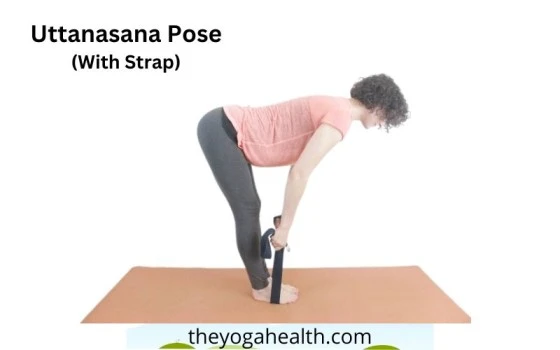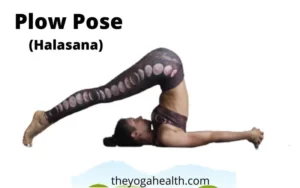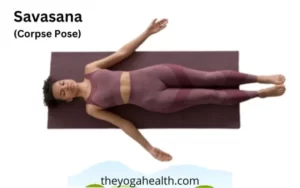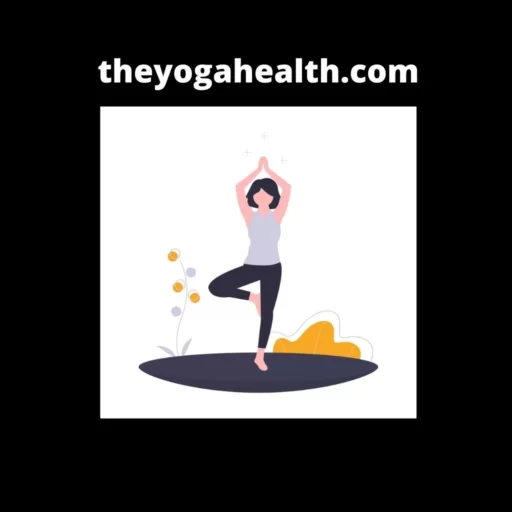Uttanasana Pose, also known as the (Standing Forward Bend), is a fundamental yoga pose that offers a multitude of physical and mental benefits. In this article, we’ll explore the details of Uttanasana pose, it’s meaning, benefits, variations, and precautions.
Table of Contents
Meaning of Uttanasana Pose:
Uttanasana is a Sanskrit term that translates to “Intense Stretch Pose.” It involves folding forward at the hips, allowing the spine to lengthen and the torso to gently rest on the legs. This pose is often practiced as part of the Sun Salutation sequence and is revered for its ability to calm the mind and enhance flexibility.
Understanding Uttanasana:
Uttanasana offers many benefits for both the body and mind. In this pose the entire backside of the body, including hamstrings, calves and spine are stretched. This pose also helps to stimulate proper blood circulation in the body. Moreover, Uttanasana has a soothing effect on the nervous system, promoting relaxation and reducing stress.
Basic Details:
| Sanskrit Name | Uttanasana |
| English Name | Standing Forward Bend |
| Difficulty Level | Intermediate |
| Position | Standing |
| Pronunciation | oot-tan-ahs-anna |
Uttanasana Benefits:
Uttanasana, the Intense Stretch Pose or Forward Fold, is more than just a simple yoga pose. It holds a treasure trove of benefits for your body and mind. Let’s delve into the numerous advantages that this foundational pose has to offer:
1. Enhanced Flexibility:
Uttanasana predominantly targets the hamstrings, calves, and spine. Regular practice of this pose increases flexibility in the body, which helps you to move more freely and with greater comfort in your daily activities.
2. Improved Posture:
The gentle stretch and lengthening effect on the spine in this pose helps to correct poor posture by promoting proper alignment and relieving tension in the back muscles.
3. Increased Blood Circulation:
In this pose the blood rushes to your head, stimulating the brain and calming the nervous system. Improved blood circulation enhances oxygen and nutrient delivery to cells, boosting overall vitality.
4. Reduced Stress and Anxiety:
The soothing nature of Uttanasana calms the mind and alleviates stress. The forward fold promotes relaxation, making it an excellent choice for calming your mind after a long day.
5. Relief from Mild Back Pain:
The pose’s gentle stretch along the spine and hamstrings can provide relief from mild lower back discomfort. It also encourages the release of tension in the muscles supporting the spine.
6. Improved Digestion:
Uttanasana massages the abdominal organs, stimulating digestion and promoting healthy bowel movements. This can be particularly beneficial if you’re prone to digestive issues.
7. Elevation of Mood:
The inversion created by Uttanasana increases blood flow to the brain, potentially lifting your mood and reducing feelings of anxiety and mild depression.
8. Relaxation for the Nervous System:
The pose’s calming effect on the nervous system triggers the parasympathetic response, inducing a state of relaxation and reducing the fight-or-flight response.
9. Balancing Hormones:
Practicing Uttanasana can help regulate the endocrine system, which controls hormone production. Hormonal balance contributes to overall well-being and emotional stability.
10. Alleviation of Headaches:
The increased blood flow to the head can help alleviate mild headaches and migraines.
11. Strengthening of Leg Muscles:
While Uttanasana may seem focused on stretching, it also engages your leg muscles. This can contribute to better muscle tone and strength.
12. Heightened Mindfulness:
The act of surrendering to the pose and focusing on your breath promotes mindfulness, encouraging you to be present and fully engaged in the moment.
13. Better Sleep Quality:
The relaxation induced by Uttanasana can extend to your sleep cycle, helping you achieve a more restful night’s sleep.
14. Enhanced Lung Function:
The expansion of the chest in the pose can lead to better lung capacity and improved respiratory health.
15. Promotes Detoxification:
The forward fold stimulates the lymphatic system, aiding in the elimination of toxins from the body.
Remember, the benefits of Uttanasana are not limited to the physical realm. As you embrace the pose, allow yourself to experience its transformative effects on both your body and mind. Whether you’re seeking stress relief, flexibility, or a boostin mood, Uttanasana offers a pathway to holistic well-being.
Healing through the pose
Practicing Uttanasana can be particularly beneficial for individuals suffering from anxiety, mild depression, or insomnia.
The pose’s gentle inversion encourages blood flow to the brain, promoting mental clarity and tranquility.
Additionally, Uttanasana’s elongating effect on the spine can alleviate mild back pain and improve posture.
How to do Uttanasana:
Step 1: Set Up Your Space
Before diving into any yoga pose, it’s essential to create a peaceful environment. Find a quiet spot with enough room for you to stretch your body comfortably. You can use a yoga mat to cushion your feet and ensure a stable base.
Step 2: Stand Tall
Begin by standing upright in Tadasana (Mountain Pose) with your feet hip-width apart. Your arms should hang naturally by your sides. This is your starting position.
Step 3: Start the Forward Bend
As you inhale deeply, raise your arms above your head, reaching for the sky. Feel the stretch along your spine. As you exhale, engage your core muscles and slowly start to fold forward at your hips.
Step 4: Reach for Your Feet
Allow your arms to continue their journey towards the floor as you bend forward. If you cannot keep your knees straight then you can slightly bend your knees to avoid straining your lower back. As you progress in flexibility, you can work on straightening your legs.
Step 5: Find Your Comfort Zone
Depending on your flexibility, you might reach your shins, ankles, or even the floor with your fingertips. The key is to find a position that challenges you but doesn’t cause discomfort. Remember, yoga is about progress, not perfection.
Step 6: Relax and Breathe
Once you’ve found your comfortable forward bend, take a few deep breaths. Inhale deeply, feeling your ribcage expand. As you exhale, let go of any tension and allow your upper body to relax further into the stretch.
Step 7: Hold the Pose
Uttanasana is a gentle inversion that encourages blood flow to your head. Hold the pose for 30 seconds to a minute, breathing steadily. If you feel any strain, slightly bend your knees or reduce the intensity of the stretch.
Step 8: Transition Out
To release the pose, bend your knees slightly and place your hands on your hips. As you inhale, engage your core muscles and slowly come up to standing, vertebra by vertebra. Roll your shoulders back and down.
A Mindful Closing:
After practicing Uttanasana, slowly roll up to a standing position. Take a moment to stand in Tadasana, feeling the effects of the pose reverberate through your body. Observe the sensations and notice how your body responds to the practice.
Breathing Awareness in Uttanasana
As you fold forward into Uttanasana, focus on your breath. Inhale deeply, feeling your chest expand, and as you exhale, allow yourself to release deeper into the forward fold.
The combination of breath and movement enhances the calming effects of the pose and encourages a more profound sense of relaxation.
Uttanasana Variations:
Prasarita Padottanasana (Wide-Legged Forward Fold): To perform this variation start by standing with your legs wide apart. Now fold forward with your hands on the floor between your legs. For a deeper strech you can even put your entire upper hand on the floor.
Ardha Uttanasana (Half Forward Fold): Fold halfway, In this variation you will not go all the way touching your belly to your thighs and you will keep your hands on your shins or thighs.
Parsvottanasana (Pyramid Forward Pose): In this variation you have to step one foot back and fold over the front leg, creating a deeper stretch.
Utthanasana with Shoulder Opener: Interlace your fingers behind your back while folding forward, allowing for a chest and shoulder stretch along with the hamstring stretch.
Prapada Uttanasana (Intense Forward Bend): In this variations the hands are moved back behind the feet and fingers are pointing towards the heels. It is very intense variation that require a lot of flexibility.
Gorilla Pose: In this variation, you start in Uttanasana and then place your palms under your feet keeping your toes at the wrists crease. If you need you can bend your knees slightly.
Uttanasana for Beginners:
For beginners, Uttanasana can be approached with slight knee bends to accommodate tight hamstrings. Placing blocks under your hands can reduce strain and help you maintain proper alignment. Gradually work on straightening your legs over time as your flexibility improves.
Performing Uttanasana Safely:
Avoid rounding your back excessively as it can strain your spine. If you have lower back issues, bend your knees generously to protect your lumbar region. Remember, the goal is to experience a gentle stretch, not discomfort.
Duration of Uttanasana:
Hold Uttanasana for about 30 seconds to 1 minute. Focus on your breath and let go of any tension with each exhale.
Tips for Beginners:
- Start with a slight knee bend.
- Use props like blocks for support.
- Focus on maintaining a straight spine.
- Breathe deeply and relax into the stretch.
- Don’t push yourself too far; progress gradually.
Preparatory & Follow-Up Poses:
Uttanasana Preparatory Poses
Prepare for Uttanasana by practicing gentle hamstring stretches like Supta Padangusthasana (Reclining Hand-to-Big-Toe Pose).
Uttanasana Follow Up Poses
Follow up with poses like Adho Mukha Svanasana (Downward Facing Dog) to lengthen the spine further.
For those seeking a deeper stretch, the Paschimottanasana variation can be explored. Sit on the floor with your legs extended in front of you. Fold forward from the hips, reaching for your feet. This variation intensifies the stretch along the hamstrings and spine.
Precautions and Contraindications:
- Avoid Uttanasana if you have severe back injuries.
- Don’t do this pose if you have recent hamstring injuries.
- In case of low blood pressure also you can avoid this pose.
- Pregnant women can avoid this pose or they can do some modifications, like practicing the pose with bent knees and support.
Uttanasana Modifications:
If reaching the floor is a challenge, place yoga blocks under your hands. The blocks offer support and allow you to maintain proper alignment.
Alternatively, practice Ardha Uttanasana (Half Forward Fold) by placing your hands on your shins. These modifications make the pose accessible to everyone, regardless of flexibility.
Using a Strap in Uttanasana
If you’re working on increasing hamstring flexibility, a strap can be a helpful tool. Loop the strap around the balls of your feet and hold the ends with your hands. As you fold forward, use the strap to gently guide your torso closer to your legs. This method enables a deeper stretch without straining your back or hamstrings.
Uttanasana a Morning Ritual:
Consider integrating Uttanasana into your morning routine. It can help awaken your body and mind, providing a gentle stretch after a night of rest. The pose’s soothing effect on the nervous system can set a positive tone for the day ahead.
Combining with Other Poses: Creating a Flow
Incorporate Uttanasana into a yoga flow by transitioning from Downward-Facing Dog. Flow into Plank Pose, then shift into Chaturanga Dandasana, Upward-Facing Dog, and finally, Downward-Facing Dog. From there, move into Uttanasana, seamlessly connecting the poses into a fluid sequence.
Embracing Regular Practice
To truly experience the benefits of Uttanasana, incorporate it into your yoga routine regularly. Consistency allows your body to adapt and become more flexible over time. Consider practicing this pose several times a week for noticeable results.
Conclusion: For Uttanasana Pose
Uttanasana Pose is more than just a physical stretch. It offers a greater connection between mind and body. It helps to achieve relaxation, renewal, and self-discovery for the practitioner. Incorporate this pose into your yoga routine and you will enjoy enhanced flexibility and reduced stress. Start your practice today and experience the transformative power of the Forward Fold firsthand.
FAQs:
Q1: What is Uttanasana?
A: Uttanasana, also known as the Standing Forward Bend, is a yoga pose that involves bending forward from the hips while keeping the spine long. In this pose, the upper body folds over the legs, allowing for a deep stretch in the back of the body.
Q2: How to do Uttanasana?
A: To perform Uttanasana Pose:
Start in a standing position with your feet hip-width apart.
Inhale and raise your arms overhead.
Exhale as you hinge at the hips, folding forward. Keep your spine straight.
Allow your arms to reach towards the ground or your legs, depending on your flexibility.
Keep your knees slightly bent to prevent straining your lower back.
Breathe deeply and you can hold the pose for 30 seconds to a minute.
To exit, engage your core, bend your knees, and slowly come back up.
Q3: Who shouldn’t do Uttanasana?
A: People with certain conditions such as back injuries, herniated discs, or severe hamstring issues should avoid Uttanasana or perform it under the guidance of a yoga instructor. Pregnant individuals or those with high blood pressure should also exercise caution.
Q4: How to improve Uttanasana?
A: To improve Uttanasana Pose:
Practice regularly: Consistent practice will gradually increase flexibility.
Warm-up: Perform gentle stretches before attempting the pose to loosen up the muscles.
Use props: Blocks or a folded blanket can help bring the ground closer if reaching the floor is challenging.
Focus on form: Ensure your spine is elongated and the weight is evenly distributed.
Q5: How long should Uttanasana be held?
A: Aim to hold Uttanasana for about 30 seconds to 1 minute. You can gradually increase the pose time duration as your flexibility improves.
Q6: What are the benefits of Uttanasana Pose?
A: Uttanasana offers several benefits, including:
Stretching and strengthening the hamstrings.
Relieving tension in the spine and back.
Calming the mind and reducing stress.
Aiding digestion and promoting better metabolism.
Improving posture and balance.
Enhancing blood circulation.
Q7: Are there any disadvantages to Uttanasana?
A: While Uttanasana has many benefits, individuals with certain conditions may experience discomfort or strain. It’s important to avoid this pose if you have injuries, herniated discs, or severe back issues.
Q8: Does Uttanasana reduce belly fat?
A: Uttanasana primarily focuses on stretching and flexibility rather than directly targeting belly fat. However, regular yoga practice, including Uttanasana, can contribute to overall weight management and a healthier lifestyle.
Q9: Is Uttanasana good for hair growth?
A: There is no scientific evidence to suggest that Uttanasana directly promotes hair growth. However, the improved blood circulation from the pose might indirectly support healthy hair by nourishing hair follicles and the scalp.
Do share your experience of doing Uttanasana Pose, it will definitely help other readers as well and if You have any question or comments regarding this Pose, you can mention so in the comments section below.






